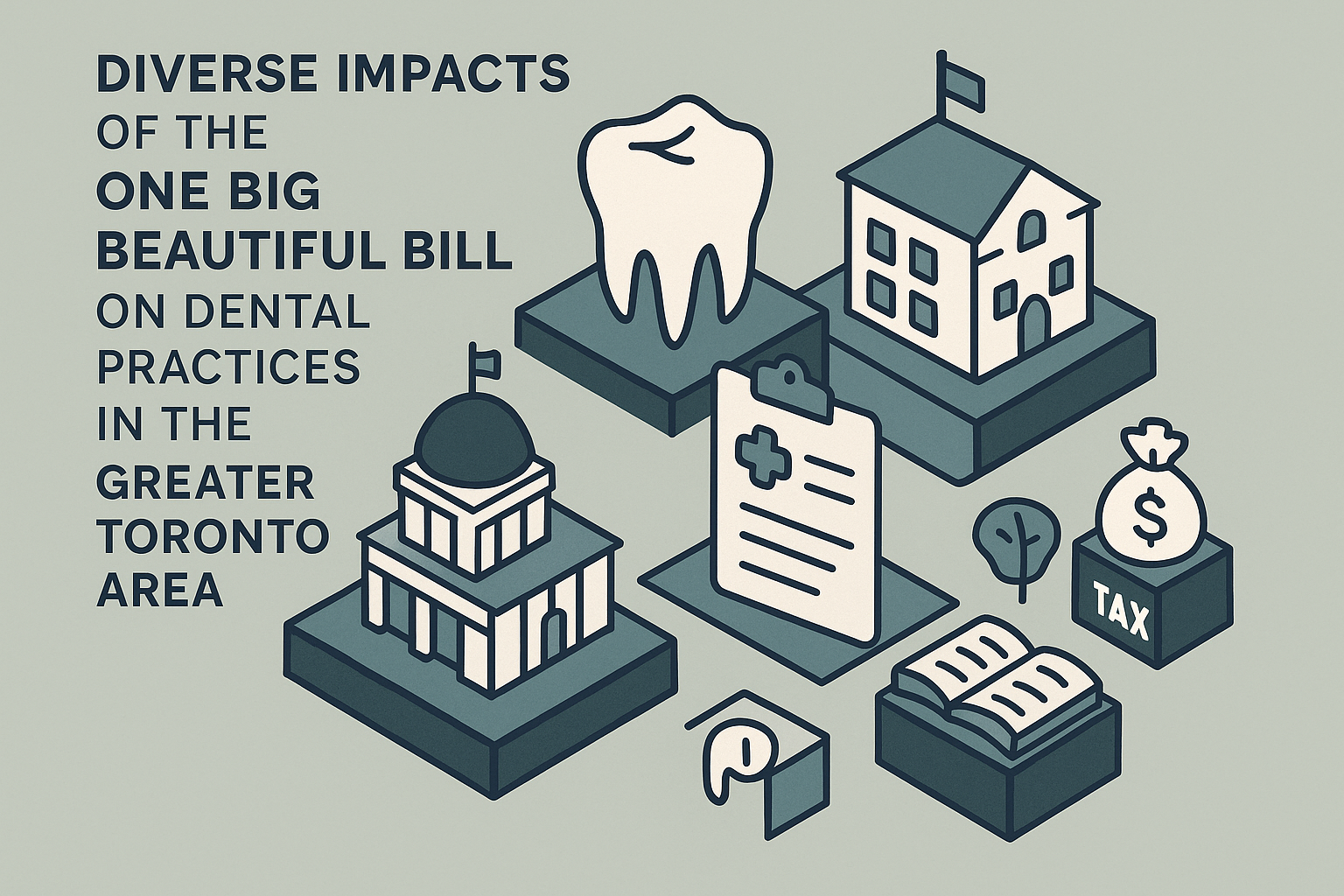Understanding the One Big Beautiful Bill: A Game Changer for Dental Practices
Unpacking the Tax Policies and Their Impacts on Dentistry in the Greater Toronto Area

The emergence of the One Big Beautiful Bill (OBBB) has introduced sweeping reforms that are directly impacting dental practices across Canada, particularly in the Greater Toronto Area (GTA). This legislation, though U.S.-originated, has comparative influences on Canadian tax interpretation, education finance, and public dental healthcare policy alignment. Whether through the restructuring of tax incentives, student loan parameters, or eligibility evaluations for publicly funded care, the implications for professionals in the dental sector are wide-ranging.
Why the One Big Beautiful Bill Matters to Canadian Dental Professionals

The weight of legislative shifts often falls heavily on small to medium-sized dental clinics. As reimbursement models evolve, financial planning changes rapidly for practices aiming to maintain top-tier service delivery. While many of the bill’s provisions are built on U.S. frameworks, parallels quickly emerge in Canada related to operational expenses, depreciation strategies, and compliance protocols—particularly for GTA-based dentists pursuing growth through reinvestment.
Tax Reform: The Practice-Level Breakdown

The following provisions within the OBBB directly or contextually influence Canadian operations, especially in aligning with Canada Revenue Agency (CRA) interpretations under incorporated dental clinics or sole proprietors:
- Restoration of the Pass-Through Entity Tax Deduction: For incorporated clinics (common in Ontario), CRA’s treatment of eligible business income resonates with U.S. deductions. Practice owners can continue to pursue tax-efficient structures without fearing abrupt increases of 1.5–5% in marginal rates.
- State and Local Tax Deduction Cap: Although SALT is specific to the U.S., its logic supports reevaluations of Ontario’s tax credits. Dental practices in the GTA can benefit through careful planning around HST inputs, municipal licensing, and operational deductions.
- Permanent 20% Small Business Income Deduction: Similar to Canada’s small business deduction (currently at a 9% federal corporate tax rate on the first $500,000), alignment in tax relief reinforces reinvestment into new equipment or staffing.
- Bonus Depreciation Resets: Practices planning to upgrade their technology—like those shopping for Endomotors or physiodispensers—can enhance ROI with accelerated capital cost allowance (CCA) claims.
- Enhanced Research Incentives: Clinics engaged in digital workflow adoption or clinical data analysis for better outcomes may unlock greater R&D deductions under the CRA’s SR&ED program.
Education Access and Its Impact on Workforce Development

For dental colleges in Ontario—particularly the University of Toronto Faculty of Dentistry and Western University—provisions related to loan limits and repayment have reflective implications:
- Graduate PLUS Loan Phase-Out: Provinces may soon respond with adjustments to the Ontario Student Assistance Program (OSAP) to mirror accessibility standards. Dental students will need alternate funding strategies tailored to program-specific credentialing years.
- Borrowing Limitations: With caps proposed ($50,000/year or $200,000 total), institutions may reconfigure tuition models or collaborative residency funding.
- Repayment Track Simplification: While reducing plan variety increases clarity, fewer options may challenge graduates navigating early-career transitions into urban versus rural practice settings.
Student Debt and Entry-to-Practice Pressure

Many recent graduates already face steep debt burdens. With average dental tuition well over $25,000/year in Ontario, the policy shift could force earlier career moves into corporate dental models or group practices to secure repayment stability. EBIKO Dental’s cost-efficient offerings—like Ultrasonic Scaler Tips or Dental Burs—can help new clinicians manage startup costs more effectively.
Evolving Medicaid and Its Canadian Parallels

While Medicaid is a U.S. program, similar models apply in Canada through provincial dental support like Ontario Works and the Ontario Seniors Dental Care Program. These could see changes in budget allocation and eligibility structures inspired by U.S. precedent:
- Bi-Annual Eligibility Reevaluations: Systems may move from annual to semi-annual assessments, increasing administrative work for clinics serving these patients.
- Patient Co-Pay Evolution: Expect adjustments in co-payment responsibilities that could increase clinic-level billing and collection efforts for low-income patients.
- Provider Tax Caps: As jurisdictions curb public provider tax models, this may reduce supplemental funding for community-based dental programs.
Policy Compliance and Patient Communication Strategies

With changing eligibility and funding models, dental practices—especially in high-density GTA regions like North York and Mississauga—should adopt more robust front-desk protocols. Patients need clearer communication around insurance options, co-pays, and federal qualifications. Staff training in practice management software and billing coding will be essential for operational sustainability.
Clinical Planning and Professional Advisory

As the legislative landscape shifts, dentists are urged to consult with financial experts and legal advisors knowledgeable in healthcare and practice law. This is especially true for independent clinics that may seek to expand or partner with service organizations. Integrating affordable, high-quality equipment allows dentists to improve efficiency and plan procurement budgets with confidence under anticipated tax adjustments.
EBIKO Dental continues to support Canadian clinicians by offering accessible product lines, including disposables, endodontics, and infection control tools that adhere to Health Canada standards.
Final Takeaways for Dentists in the GTA
While the One Big Beautiful Bill marks a significant shift in how dental services may be funded and managed, its ripple effect across North American regulatory structures is beginning to influence Canadian environments. By staying informed, engaging in proactive financial review, and leveraging partners like EBIKO Dental, practices can remain resilient and growth-oriented amid systemic change.

